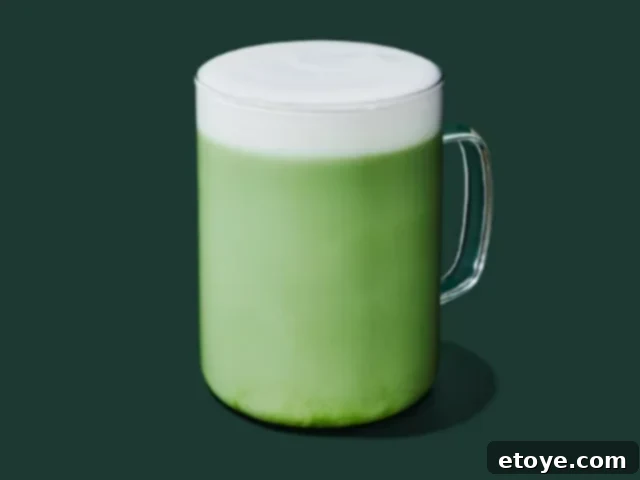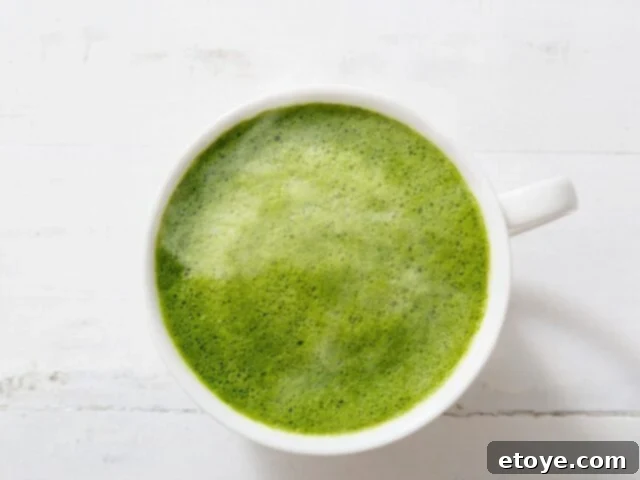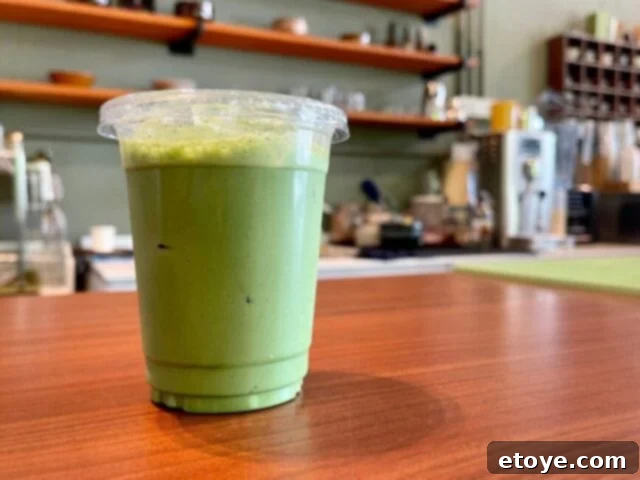Are you one of the millions captivated by the enchanting Starbucks Green Tea Matcha Latte? Its vibrant color, creamy texture, and uniquely earthy-sweet flavor have made it a global phenomenon. Perhaps you’ve found yourself pondering the magic behind this delightful concoction, wondering what makes it so irresistibly delicious, and more importantly, if you could recreate that magic in your own kitchen. You’re in the right place! We’re about to embark on a comprehensive journey to demystify the Starbucks Green Tea Matcha Latte. We’ll uncover its essential ingredients, explore the art of its preparation, delve into the surprising health benefits it offers, and even guide you on how to craft a perfect, customizable version right at home. Prepare to discover why this dreamy drink is truly much more than meets the eye – or your discerning taste buds.

Photo: Starbucks
Unveiling the Starbucks Green Tea Matcha Latte: What’s Inside?
For those eager to get straight to the point, let’s reveal the core components of a Starbucks Green Tea Matcha Latte. At its heart, this beloved beverage is a harmonious blend of hot water, your preferred choice of milk (ranging from classic dairy options like whole or skim milk to popular plant-based alternatives such as almond milk or oat milk), and a special matcha tea blend. This blend is crucial, typically consisting of finely ground green tea powder and sugar. The matcha powder is the star, imparting its distinctive earthy, slightly bitter, yet refreshing flavor, alongside a welcome boost of natural caffeine – a Grande size, for instance, typically contains around 80 milligrams. This unique profile makes it a compelling alternative for those looking to diversify their coffee routine or simply enjoy a comforting, energizing drink.
But there’s much more to learn about this popular Starbucks favorite. Let’s dive deeper into the world of matcha and explore the nuances that make this drink truly special.

Photo: Starbucks
What Exactly is a Matcha Latte? A Journey from Leaf to Cup
Often interchangeably referred to as Green Tea Lattes, Matcha Lattes represent a delightful fusion of finely ground green tea leaves and milk, meticulously blended to achieve a smooth, creamy, and visually appealing drink. To truly understand a matcha latte, it’s essential to differentiate matcha from conventional green tea. While traditional green tea is typically brewed by steeping tea bags or loose leaves in hot water, matcha involves a much more intricate process.
Matcha originates from Japan, with a rich history rooted in Zen Buddhist traditions dating back centuries. Unlike other green teas, the tea plants for matcha are shade-grown for several weeks before harvest. This unique cultivation method boosts chlorophyll production, resulting in the tea leaves’ vibrant green color and enhancing their amino acid content, particularly L-theanine. After harvesting, the leaves are steamed, dried, and then stone-ground into a fine, emerald-green powder. When you drink matcha, you’re consuming the entire tea leaf, which means you receive a more concentrated dose of its beneficial compounds compared to merely steeping and discarding leaves.
The preparation of matcha involves whisking this high-quality powder into warm water, creating a frothy, vibrant tea. When milk is added, it transforms into the beloved matcha latte, offering a unique taste profile that blends vegetal notes with a hint of natural sweetness and often a creamy finish. Its distinctive flavor and impressive health benefits have propelled its popularity far beyond its Japanese origins, making it a staple in cafes across the US and worldwide. Whether served hot and comforting or iced and refreshing, matcha lattes are incredibly versatile, perfect for any season or mood. Matcha itself has found its way into a myriad of culinary creations, from refreshing matcha lemonade to tropical iced pineapple matcha drinks, showcasing its adaptability as a truly exceptional ingredient.

Understanding Matcha Grades: A Spectrum of Quality and Purpose
The burgeoning global love affair with matcha has brought about excellent news for aficionados: high-quality matcha powder is now more accessible than ever, allowing you to experience this verdant elixir at its finest. However, it’s a common misconception that all matcha is created equal. In reality, matcha is categorized into different grades, each meticulously crafted for specific applications and offering distinct sensory experiences.
Ceremonial Grade Matcha: The Pinnacle of Purity
Ceremonial grade stands as the highest quality of matcha available. It is exclusively made from the youngest, most tender tea leaves, harvested during the first flush of spring. These leaves are meticulously de-stemmed and de-veined before being stone-ground, ensuring a supremely fine texture. Characterized by its incredibly vibrant, almost luminous green color and a remarkably smooth, subtly sweet, umami-rich flavor profile, ceremonial grade matcha is traditionally reserved for Japanese tea ceremonies. Its delicate taste is best appreciated when simply whisked with hot water, without any additions, allowing its pure essence to shine through.
Culinary Grade Matcha: Versatility in the Kitchen
Culinary grade matcha, as its name suggests, is designed for use in cooking and baking. It is derived from slightly older tea leaves and often includes leaves from later harvests. This results in a stronger, more robust, and sometimes slightly more bitter taste, making it ideal for standing up to other ingredients in recipes. While its color may be less vibrant than ceremonial grade, it still offers excellent flavor and nutritional benefits. Within the culinary grade, you might find sub-categories like “premium culinary” or “latte grade,” which offer a good balance for everyday drinks.
Starbucks’ Matcha Blend: A Balanced Approach
Starbucks utilizes a proprietary matcha blend that falls somewhere between premium culinary and culinary grade. This blend is optimized for consistency and flavor profile that pairs well with milk and sweeteners on a mass scale. It’s crucial for consumers to note, however, that the primary ingredient in Starbucks’ green tea powder blend is, in fact, sugar. A Grande Matcha Latte can contain around 32 grams of sugar from the blend alone, before any additional sweeteners are added. This is an important consideration for anyone monitoring their sugar intake or seeking a truly “healthy” beverage. If reducing sugar is a priority, keep reading to discover how you can craft your own, healthier rendition of Starbucks’ Green Tea Latte from the comfort of your home, with full control over the ingredients.
Despite the sugar content, there are undeniable perks to indulging in this delightfully sweet drink. Let’s explore the compelling reasons why Starbucks’ Green Tea Matcha Latte continues to be a cherished choice for so many.
The Profound Health Benefits of Matcha: Beyond a Simple Drink
Beneath its appealing taste and creamy texture, a Starbucks Matcha Latte (and matcha in general) harbors a surprising array of health benefits, primarily attributed to the potent antioxidants and unique compounds found in matcha. This makes it much more than just a refreshing beverage; it’s a wellness elixir.
Antioxidant Powerhouse: Fighting Free Radicals
One of the most celebrated components of matcha is epigallocatechin gallate (EGCG), a powerful catechin. EGCG is a robust antioxidant known for its exceptional ability to combat free radicals in the body, which are unstable molecules that can damage cells and contribute to chronic diseases and aging. Regular consumption of matcha, rich in EGCG, can significantly bolster the body’s defense mechanisms, reducing oxidative stress and supporting overall cellular health.
Calm Focus with L-Theanine
Matcha is also notably rich in amino acids, especially L-theanine. This unique amino acid works synergistically with caffeine, promoting a state of “calm alertness.” L-theanine encourages alpha wave activity in the brain, which is associated with a relaxed, yet focused mental state. Unlike the jittery energy sometimes experienced with coffee, matcha provides a gentle, sustained energy boost without the typical crash, making it an excellent choice for enhancing mental clarity, concentration, and productivity without overstimulation.
Immune Support and Radiant Skin
Thanks to its comprehensive profile of vitamins (such as C, K, and A) and minerals (including potassium, iron, and calcium), matcha is a fantastic ally for your immune system. These nutrients play vital roles in various bodily functions, contributing to robust health. Furthermore, the antioxidants and vitamins in matcha can significantly contribute to skin health, helping to protect against environmental damage and promote a more radiant complexion.
Cardiovascular Health and Metabolism
Emerging research suggests that regular matcha consumption may contribute to cardiovascular health by helping to lower high blood pressure and reduce the risk of heart disease. Its compounds can also support a healthy metabolism and assist in maintaining a healthy weight. The presence of chlorophyll, which gives matcha its vibrant green hue, is also believed to have detoxifying properties, aiding the body in cleansing itself of toxins.
Of course, the moderate caffeine content provides a gentle energy lift, helping you stay alert and energized throughout the day without the abrupt peaks and valleys often associated with other caffeinated beverages.

The Art of Customization: Crafting Your Perfect Matcha Latte at Starbucks
One of the most appealing aspects of the Starbucks Matcha Latte is its remarkable ability to be endlessly customized, allowing you to tailor it precisely to your taste preferences and dietary needs. This versatility ensures that there’s a perfect matcha latte for everyone.
Milk Choices: Enhancing Texture and Flavor
The type of milk you choose can dramatically alter the texture and flavor profile of your latte. For a rich, indulgently creamy base, traditional whole milk or 2% dairy milk are classic choices. If you prefer a lighter feel or have specific dietary requirements, Starbucks offers an impressive array of plant-based options. Coconut milk lends a subtly tropical note, almond milk provides a delicate nuttiness, soy milk offers a creamy texture with a distinct flavor, and oat milk delivers exceptional creaminess and a hint of natural sweetness. Starbucks even offers their unique Original Nut Blend (a vegan option crafted with rice milk, hazelnuts, and cashews) for those seeking an innovative dairy-free experience.
Sweeteners and Flavor Infusions: Personalizing Your Palate
While Starbucks’ matcha powder blend already contains sugar, you have the option to further customize the sweetness and introduce additional flavors. Classic choices include regular sugar or various flavored syrups. For a more natural touch, you can opt for their honey blend or explore a diverse range of taste infusions through their assortment of flavored syrups. Imagine caramel for a decadent treat, cinnamon dolce for a warm spice, toasted vanilla for a comforting aroma, or toffee nut for a rich, buttery sweetness. Seasonally, you might even find unique offerings like pumpkin spice. Beyond syrups, Starbucks also features a small selection of sauces, such as white chocolate and mocha, allowing for even more creative combinations. Feel free to mix and match these options to craft a truly unique and personalized matcha latte experience that perfectly suits your mood.
Beyond the Basics: Advanced Customizations
For adventurous drinkers, the customization possibilities extend even further. Consider adding an espresso shot for a “dirty matcha” – a delightful fusion of coffee and tea. A scoop of protein powder can transform your latte into a post-workout treat. You can also ask for it blended for a refreshing “matcha frappuccino” style drink, or topped with whipped cream and a drizzle of your favorite sauce for an extra touch of indulgence.
Crafting Your Own Starbucks Iced Matcha Latte at Home: A Superior Experience
If you cherish the taste of a Starbucks Green Tea Latte, prepare to fall even more in love with a homemade version. Brewing your own matcha latte at home offers a multitude of compelling advantages that often surpass the cafe experience.
- Significant Cost Savings: Enjoying a daily matcha latte from Starbucks can quickly become an expensive habit. Investing in high-quality matcha powder and making your own allows for substantial savings over time, especially for frequent drinkers.
- Reduced Calorie and Sugar Intake: One of the biggest advantages of homemade matcha is gaining full control over ingredients. By choosing unsweetened matcha powder, you immediately eliminate the 32 grams of sugar found in Starbucks’ blend, drastically cutting down on calories and sugar, making it a much healthier choice.
- Pure, Natural Flavors: When you prepare matcha at home, you can avoid the artificial food colorings, preservatives, and chemical additives that are sometimes present in commercially prepared matcha drinks. You get to enjoy the pure, unadulterated taste of authentic green tea.
- Superior Taste and Quality: By selecting premium unsweetened matcha powder, you can achieve a depth of flavor and a richness that often far surpasses the standardized taste of mass-produced café versions. Experience matcha as it was truly intended to be enjoyed.
Ready to savor a delicious, healthier Starbucks-style Iced Matcha Latte from the comfort of your own kitchen? Here’s a simple, yet incredibly satisfying copycat recipe you can whip up in minutes.
Homemade Iced Matcha Latte Recipe
Ingredients:
- 1-2 teaspoons high-quality, unsweetened matcha powder (adjust to desired strength)
- 1 tablespoon of your preferred sweetener (e.g., maple syrup, agave, honey, stevia, or simple syrup)
- 1 cup milk (any kind you prefer: whole milk, almond milk, oat milk, soy milk, coconut milk)
- 1/4 cup warm water (around 175°F / 80°C – not boiling)
- Ice cubes
- Optional: 1/2 teaspoon vanilla extract for added depth of flavor
Instructions:
- Prepare the Matcha: Sift the matcha powder into a small bowl or a matcha bowl (chawan) using a fine-mesh sieve or a matcha sifter to remove any clumps. This step is crucial for a smooth, lump-free drink.
- Whisk the Matcha: Add the warm water (ensure it’s not boiling, as excessively hot water can make matcha bitter) to the sifted matcha. Using a bamboo matcha whisk (chasen) or a small electric milk frother, whisk vigorously in a “W” or “M” motion until the matcha is fully dissolved, frothy, and a beautiful bright green. This typically takes about 30-60 seconds.
- Assemble Your Latte: In a separate tall glass, add a generous amount of ice cubes. Pour in your chosen milk.
- Combine and Sweeten: Gently pour the prepared frothy matcha mixture over the milk and ice. Add your preferred sweetener (and vanilla extract, if using). Stir well with a spoon or straw until all ingredients are thoroughly combined and the sweetness is to your liking.
- Enjoy: Take a sip and revel in your perfectly crafted, refreshing, and healthier homemade iced matcha latte!

It’s Matcha Time! Embrace Your Matcha Journey
There you have it! A comprehensive guide packed with all the insights you need to fully appreciate, customize, and even replicate the enchanting Starbucks Green Tea Matcha Latte. Whether you choose to enjoy the convenience of a personalized drink from your local Starbucks barista or embark on the rewarding journey of crafting your own perfect matcha latte at home, the knowledge is now at your fingertips. Knowing that you’re equipped to savor this delightful beverage exactly as you like it brings a smile to our faces.
Do you have any cherished matcha recipes, unique customization tips for Starbucks, or clever tricks for making your homemade matcha even better? We would absolutely love to hear about your experiences! Please share your insights and personal matcha secrets with us and the rest of our community in the comments below. We thrive on community knowledge, delight in your stories, and are always eager to discover and try something new.
Craving More Delightful Drinks? Explore Our Other Recipes!
- The Best Starbucks Vanilla Coffee Drink for You
- Vietnamese Iced Coffee (Cafe Sua Da) Recipe
- Thai Iced Coffee Recipe
- Healthier Pumpkin Spiced Latte Tips for a Guilt-Free Fall Season
